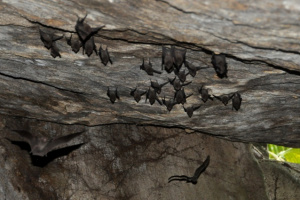World's rarest bat: Seychelles' critically endangered sheath-tailed bat found in 4 more locations
Species |Author: Juliette Dine Edited By: Betymie Bonnelame | October 25, 2023, Wednesday @ 10:31| 33044 views
The Seychelles sheath-tailed bat in a cave on Silhouette Island (archive- Island Conservation Society)
The Seychelles endemic sheath-tailed bat, a species listed as critically endangered on the International Union for Conservation of Nature's (IUCN) Red List, has been spotted in four new locations in the country by a non-profit organisation.
The sheath-tailed bat, commonly known by locals as "sousouri bannann" and known as the world's rarest bat, can be distinguished from others by the sheath behind its hind legs.
Protect Paradise Seychelles, an NGO dedicated to conserving Seychelles' unique biodiversity, was involved in a research project aimed at uncovering new locations of the Seychelles sheath-tailed bat using acoustic bat monitors.
The project was undertaken by Nils Bouillard, the Red List Authority Coordinator for European Bats and the managing director at Barbastella Echology. He has been studying bats, mainly using acoustic recorders for over 10 years now.
 |
| The research project was aimed at uncovering new locations of the Seychelles sheath-tailed bat using acoustic bat monitors. (Protect Paradise Seychelles) Photo License: All Rights Reserved |
The primary objective of the project was to gain a deeper understanding of the species' habitat preferences and distribution across the Seychelles archipelago in the western Indian Ocean.
Bouillard told SNA that ever since his first visit to Seychelles, where he was lucky enough to see and record the world's rarest bat, he wanted to come back and conduct a large-scale acoustic survey, targeting as many places as possible in the hope of discovering new populations.
"In September 2023, with the help of Protect Paradise Seychelles, we were able to do just that as we located no fewer than four new locations for this species. The new populations we discovered are all on the southwest coast of Mahe as that is the only area where there are still places of suitable habitat left untouched," he explained.
Bouillard said the acoustic survey used "is a perfect blend of two of my passions, technology, and bats. So, we used ultrasonic recorders that cleverly trigger when they hear a bat fly-past. By recording their echolocation calls, we can identify which species they belong to. On the granitic islands of Seychelles, this process is very easy because only the sheath-tailed bat echolocates."
As for what the finding means for the biodiversity of Seychelles, he told SNA that "this study definitely acts as a proof of concept that the methods used are highly suitable under these circumstances and could lead to similar projects on other islands in Seychelles, including the outer Island that other bat species call home."
He added "however, this study is also a stark reminder of the issues facing this bat species. Its habitat is shrinking every day as more developments are planned along the coast, destroying the few areas left where this species can live. Finding four new locations sounds like fantastic news but the prospects of survival of this species are still very grim."
 |
| Bouillard conducting his research. (Protect Paradise Seychelles) Photo License: All Rights Reserved |
Bouillard said that this species is still very much under threat.
"This species appears to mostly roost in small groups of 30 individuals or fewer. The large roosts described in the literature from a century or two ago are gone for good. So, we are dealing with a highly fragmented population requiring undisturbed forest with large boulders and caves along the coast. This habitat also happens to be prime real estate for resort development. It would not take much for this species to disappear completely and if those populations are not protected, the species could be gone in our lifetime," he told SNA.
Prior to the research, only two or three sites were known to be home to the sheath-tailed bat, the biggest being on Silhouette Island, and Bouillard said the number was increased to seven, giving a better chance at protecting the species.
"Those roosts have probably always been there but now that we know where they are, we can protect them. It is a common issue in bat conservation to have to protect a species without knowing where they roost or how many there are. This even applies to commonly encountered species such as the Seychelles flying fox for which no reliable country-wide population estimates or trends exist - and it is likely declining. So, it is easy to imagine how much more difficult it is to collect that data for a species 40 times smaller," he explained.
The data and the conclusion of the finding have been sent to the Ministry of Agriculture, Climate Change and Environment so that it can take proper action to ensure that the newly discovered populations are protected.
"As a member of the IUCN Bat Specialist Group, I have been tasked with leading the update of its IUCN Red List assessment, along with other researchers who are currently working on the species, on Silhouette for example. This assessment will be used as a basis for future conservation plans," said Bouillard.
As for Protect Paradise Seychelles, it will make use of the data to contribute to the species' conservation by identifying previously unknown roosting and foraging locations, thereby enhancing protection measures.
Back
